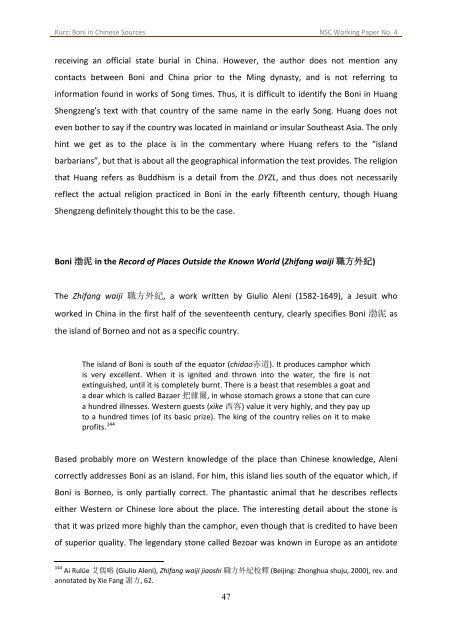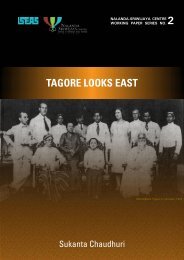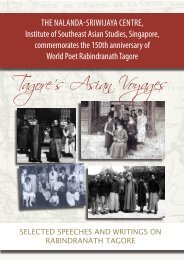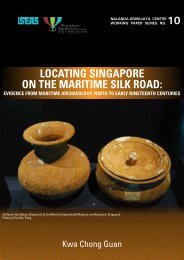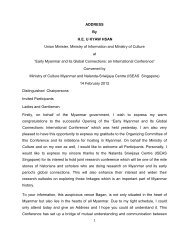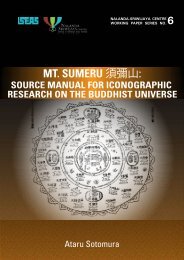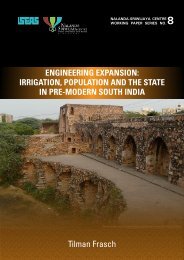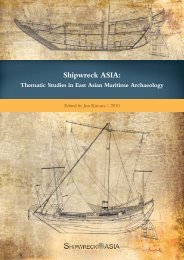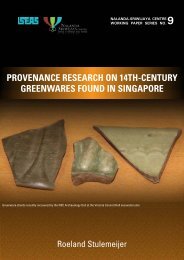Kurz: <strong>Boni</strong> <strong>in</strong> Ch<strong>in</strong>ese <strong>Sources</strong> NSC Work<strong>in</strong>g Paper No. 4sent there to give them a banquet and reward them, and it was ordered that everyprefecture that they passed through [on their way to the capital] was to banquetthem. After arriv<strong>in</strong>g at the capital, the k<strong>in</strong>g submitted a memorial written <strong>in</strong> goldencharacters and many precious objects, while his consort presented a letter and localproducts to the Central Palace (of the imperial consort) and the Eastern Palace (ofthe crown pr<strong>in</strong>ce). The emperor personally enterta<strong>in</strong>ed the k<strong>in</strong>g with a banquet atthe Fengtian Gate. That same year when the k<strong>in</strong>g had died <strong>in</strong> the Interpreter’sInstitute <strong>in</strong> Nanj<strong>in</strong>g, all court bus<strong>in</strong>ess was suspended for three days, and he wasgiven lavish sacrifices. An imperial decree conferred the posthumous name ofGongshun 恭 順 (Respectful and Obedient) onto him, and his was given a burial at theShizigang, south of the city walls of Nanj<strong>in</strong>g. Southwestern yi 夷 ‐people, who wereregistered <strong>in</strong> Ch<strong>in</strong>a, were to guard [the tomb], a commemorative stele was set upand a shr<strong>in</strong>e was built, and it was officially ordered that sacrifices were to be heldevery spr<strong>in</strong>g and autumn. By another order his son Xiawang was conferredsuccession to the throne, and a eunuch and a messenger were dispatched toaccompany him back home. Both <strong>in</strong> the twelfth year [of the Yongle era (1414)] andthe first year of the Hongxi era (1425), [envoys] came with tribute to the court.)Their tribute products were as follows: pearls, gems, golden f<strong>in</strong>ger r<strong>in</strong>gs, golden silkbraided r<strong>in</strong>gs, camphor, chipped camphor, plum blossom camphor, <strong>in</strong>cense, highqualitygharu wood, sandalwood <strong>in</strong>cense, cloves, cardamom, bee’s wax, rh<strong>in</strong>oceroshorn, tortoise shell, carapaces, snail shells, hornbill beaks, bearsk<strong>in</strong>s, peafowl, lories(daoguaniao 倒 掛 鳥 ), multi‐coloured parrots, black page boys, and cutlery madefrom precious materials.I comment: I once traveled to J<strong>in</strong>l<strong>in</strong>g, and arriv<strong>in</strong>g at the Shizigang, passed by thetomb of the Respectful and Obedient k<strong>in</strong>g of <strong>Boni</strong>. I could not but admire theemperor’s treatment of the island barbarians and celebrate his meet<strong>in</strong>g theRespectful and Obedient. Dur<strong>in</strong>g the times of the August Emperor (the Hongwuemperor) the Office Manager Shen Zhi and the Censor Zhang J<strong>in</strong>gzhi upon orders wentto that country to <strong>in</strong>struct them. When they had arrived there, they made the k<strong>in</strong>gcome down from his seat and ordered him to bow to the court. Furthermore [theymade] him say: “The emperor is the ruler of all under Heaven, and he is my pr<strong>in</strong>ce andfather.” Such were the words that he uttered. That our two officials rejected hispresents of golden knifes and cotton, and that later on he would respect Ch<strong>in</strong>a and behappy to submit himself — this is extraord<strong>in</strong>ary <strong>in</strong>deed!! 143The entry does not provide new or more detailed <strong>in</strong>formation on <strong>Boni</strong>. The open<strong>in</strong>gparagraph of the text is based on the DYZL description of the country, recount<strong>in</strong>g aga<strong>in</strong>, thatdrunk Ch<strong>in</strong>ese will be helped by the locals. The text then turns to describe the start of thediplomatic relations between <strong>Boni</strong> and Ch<strong>in</strong>a from 1370 to 1425. Huang mentions only twomissions from <strong>Boni</strong>, namely <strong>in</strong> 1414 and 1425. The tribute products he lists, clearly are ofSoutheast Asian provenance, but it is rather impossible to identify the provenance of theblack page boys. Huang moreover does not miss the irony of Mamosha treat<strong>in</strong>g the firstenvoys quite arrogantly, while Manarejiananai, who himself arrived as a guest, was143 XCD, 1.44‐46.46
Kurz: <strong>Boni</strong> <strong>in</strong> Ch<strong>in</strong>ese <strong>Sources</strong> NSC Work<strong>in</strong>g Paper No. 4receiv<strong>in</strong>g an official state burial <strong>in</strong> Ch<strong>in</strong>a. However, the author does not mention anycontacts between <strong>Boni</strong> and Ch<strong>in</strong>a prior to the M<strong>in</strong>g dynasty, and is not referr<strong>in</strong>g to<strong>in</strong>formation found <strong>in</strong> works of Song times. Thus, it is difficult to identify the <strong>Boni</strong> <strong>in</strong> HuangShengzeng’s text with that country of the same name <strong>in</strong> the early Song. Huang does noteven bother to say if the country was located <strong>in</strong> ma<strong>in</strong>land or <strong>in</strong>sular Southeast Asia. The onlyh<strong>in</strong>t we get as to the place is <strong>in</strong> the commentary where Huang refers to the “islandbarbarians”, but that is about all the geographical <strong>in</strong>formation the text provides. The religionthat Huang refers as Buddhism is a detail from the DYZL, and thus does not necessarilyreflect the actual religion practiced <strong>in</strong> <strong>Boni</strong> <strong>in</strong> the early fifteenth century, though HuangShengzeng def<strong>in</strong>itely thought this to be the case.<strong>Boni</strong> 渤 泥 <strong>in</strong> the Record of Places Outside the Known World (Zhifang waiji 職 方 外 紀 )The Zhifang waiji 職 方 外 紀 , a work written by Giulio Aleni (1582‐1649), a Jesuit whoworked <strong>in</strong> Ch<strong>in</strong>a <strong>in</strong> the first half of the seventeenth century, clearly specifies <strong>Boni</strong> 渤 泥 asthe island of Borneo and not as a specific country.The island of <strong>Boni</strong> is south of the equator (chidao 赤 道 ). It produces camphor whichis very excellent. When it is ignited and thrown <strong>in</strong>to the water, the fire is notext<strong>in</strong>guished, until it is completely burnt. There is a beast that resembles a goat anda dear which is called Bazaer 把 雜 爾 , <strong>in</strong> whose stomach grows a stone that can curea hundred illnesses. Western guests (xike 西 客 ) value it very highly, and they pay upto a hundred times (of its basic prize). The k<strong>in</strong>g of the country relies on it to makeprofits. 144Based probably more on Western knowledge of the place than Ch<strong>in</strong>ese knowledge, Alenicorrectly addresses <strong>Boni</strong> as an island. For him, this island lies south of the equator which, if<strong>Boni</strong> is Borneo, is only partially correct. The phantastic animal that he describes reflectseither Western or Ch<strong>in</strong>ese lore about the place. The <strong>in</strong>terest<strong>in</strong>g detail about the stone isthat it was prized more highly than the camphor, even though that is credited to have beenof superior quality. The legendary stone called Bezoar was known <strong>in</strong> Europe as an antidote144 Ai Rulüe 艾 儒 略 (Giulio Aleni), Zhifang waiji jiaoshi 職 方 外 紀 校 釋 (Beij<strong>in</strong>g: Zhonghua shuju, 2000), rev. andannotated by Xie Fang 謝 方 , 62.47


